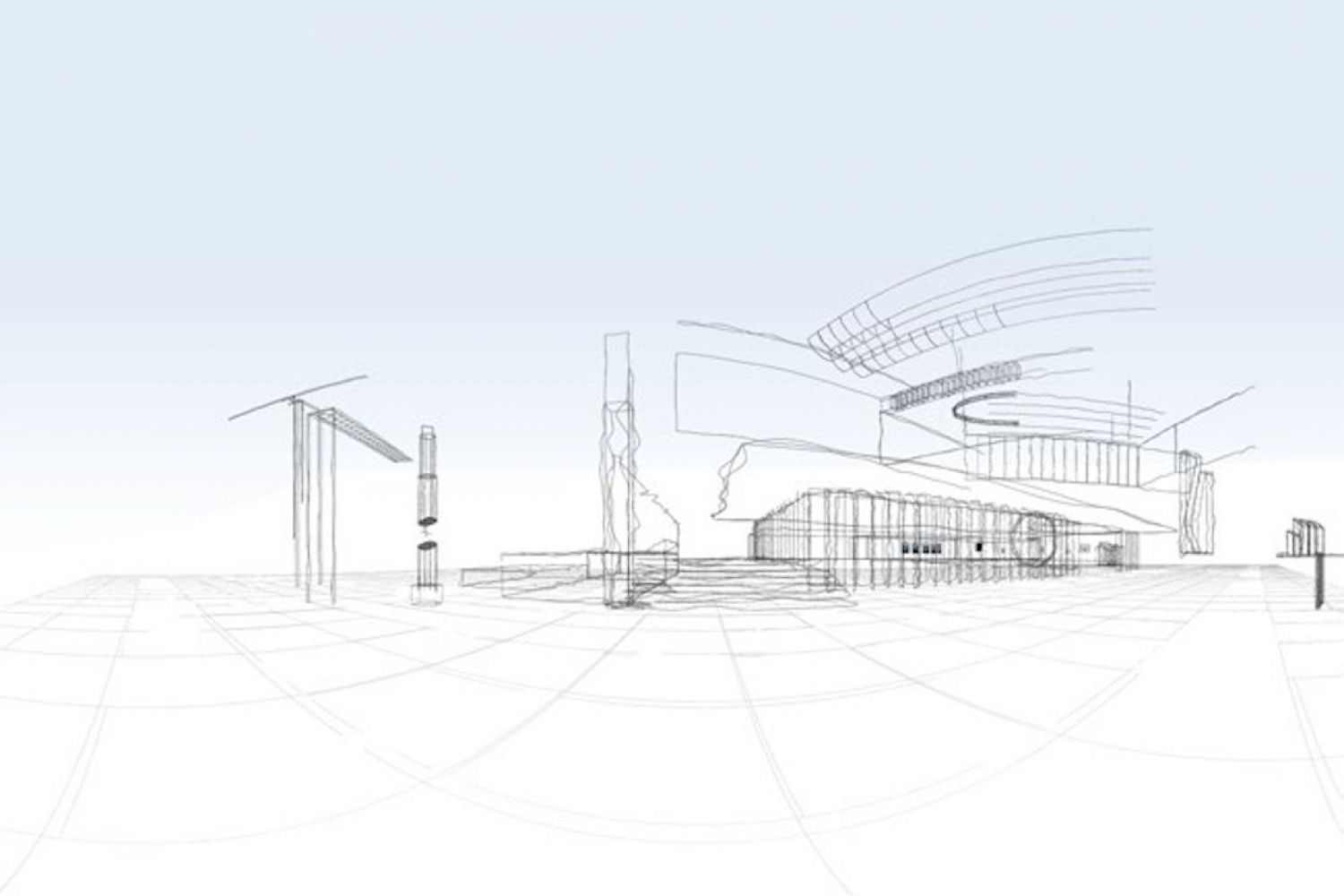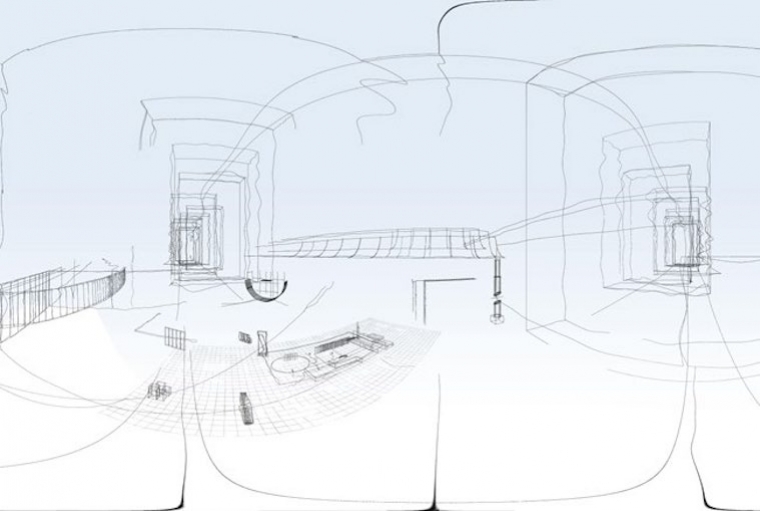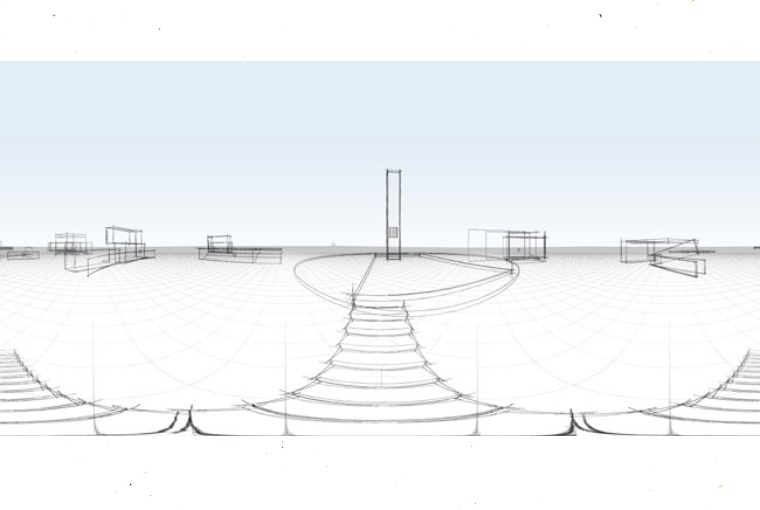

“Virtual reality is very physical. I won’t just see changing images on a flat screen; I will have the feeling of occupying those images with my entire body. I will enter a graphic three-dimensional computer constructed world that does not look real but feels real, one that may respond immediately to my movements and commands.” - Karen Franck
The first examples of ‘other worlds’ emerge in literature and science fiction. These ‘other worlds’ have been located in parallel universes, imagined away from our sensorial world, under our earth, above our earth and in other galaxies. Fascination for these worlds is a very old preoccupation, with its more recent avatars in cinema and the gaming world. Although insertion of computer models in cinema began in the 1970s— ‘Star Wars’ one of the earliest examples—it is now common for actors to act against green screens that are later filled with computer generated contexts, representing these imaginary worlds. Within contemporary architecture, the use of computer software to help visualise ideas is common and important. From basic modelling software that creates recti- linear volumes to more complex parametric formulating software, we model unbuilt forms to test ideas and develop designs for projects. The virtual has become a core component of the process of designing real world buildings. While designing, modelling software accounts for natural light using geographical location, latitude and longitude, time of year and the time of day. It also accounts for materiality by allowing veneers to create the surfaces of the buildings. The software helps deal with structures that address gravity, temperature and even local context. Most of this information is fed into the computer but the existence of a site dictates all aspects of the architectural context to the designer. Unlike cinema, video games and science fiction, these models of buildings are situated on Earth (for the most part.) They all have a site.
This is also true for almost all architectural propositions – student works, competitions and unbuilt and abandoned projects. However, today’s pandemic and the need for physical distancing amplifies the need to replicate physical and social experiences in virtual space. Events are reimagined as cyber events, meetings are being replaced by online communication and physical event zones are increasingly, albeit momentarily, becoming redundant. Moreover, the innate human desire for familiarity pushes us faster into mimicking the physicalness of the sensory world experience. The new normal is in cyberspace.
The term cyberspace was coined by William Gibson in his 1984 novel ‘Neuromancer’. He describes cyberspace; as an electronic world awaiting our imagination and inhabitation. Without deviating much from the original meaning given to the term, it has, over the past few decades, entered common usage. The Oxford dictionary defines it as – ‘the Internet considered as an imaginary space without a physical location in which communication over computer networks takes place’.
Many, if not most, current cyberspace experiences, yearn for form and materiality as they exist in the real sensory world. Video games and cinema borrow large aspects of our sensory world and tweak them to create ‘other worlds’ to help navigate the user and viewer through these spaces – all using forms and materials of familiarity. But what happens if a space is solely intended to be designed, conceived and remain in cyberspace? What are its parame- ters and its rules, when nothing of the physical world applies to its inherent logic? What does virtual architecture offer in a time of limited social mobility and minimal travel? How do we build for a site in cyberspace?
After all, the only constraints within which one can create in cyberspace are our imagination and the limits of a computer’s ability. Within these new parameters, is there a post-pandemic cyber aesthetic? Cyber space has the ability to reimagine aspects of architecture, aspects that are not possible in the sensory world. I propose that the virtual space need not be a recep- tacle to a virtual built volume but instead be a site for ‘thought’. A space where physical representation of buildings does not exist. Only thoughts of buildings exist. This note explores the cyber space and its parameters and architecture for a site-less site.

I would first like to address some basic principles of space, site, scale, mate- riality and directionality in this imagined cyber space. Once we enter cyberspace, the rules of our world, as we experience it, cease to hold true. Like cinema, there is no light (except a backlit screen), no gravity, no climate, no material relevance, no con- text and no sensory perceptions, except time and sight. Within this context, a crumpled piece of paper could just as easily be enlarged to create a building or equally, the viewer could shrink to enter the tiny crevices of a rock formation to inhabit the microscopic terrain. All such actions are relevant and all such actions will create enclosures of some form or the other. There are infinite possibilities and there are infinite freedoms. These freedoms are from the physical conception of the world as we inhabit it as well as from the moralistic world as we know it. While there is a whole different conversation to be had about moralistic and societal freedoms in the cyber world, I limit this conversation to the physical and sensory world.
SPACE AND CONTEXT
While considering the ideas of site and context and eventually time in this space, I assume the starting point of space as a Tabula Rasa. Before any action occurs within this space, it is important to consider its properties, just like an architect would a site. Except here, I am forced to question the most basic of ideas of space and its meaning.
To begin, there needs to be a formulation of the rules of space and for argu- ment’s sake, I will propose to work within three dimensionally represented Cartesian spaces. In Euclidean and Cartesian space models, there are three axes and directionality. Perception and experience of space follow the laws of perspective: a vanishing point along one, two or three axes. From these geometries have emerged means of mapping the world as we know it and these geometries have laid down the ground for architectural and scientific enquiry in the western world through history. And when considering the sensory world, for most of us, these laws dictate the logic of space to us. There are, of course, newer ideas of space that don’t subscribe to the Cartesian ideas of space but a large part of that thinking relates to the conception of the universe more broadly. Here, I keep us within the more common understanding of space.
Given that the experience of virtual space is both visual and temporal as we move through it, I borrow from the most basic geometric square grid to establish a context for the proposition. The grid is square, it is infinite and has no scale. The one main thing the grid does is to lay out a logic of space, by referencing its own component squares in relation and proximity to each other to create a sense of infinity and through perspective a sense of distance. A grid has been used to map existing and imagined ter- rains, the square grid has been employed to survey maps of the world and these square grids remain in use for mapping exercises. It also remains a key guide in drafting and visual representation in the form of graphs. In this sense of mapping, the logic of geometry alludes to a field of events and space.
The grid, while establishing a context for the project, does so while establishing a completely neutral context allowing for what is proposed on it to relate mostly to itself. If there is nothing that exists prior to the grid in cyberspace, then the only context that is established in this space has to be the absence of a context within this space. For this project to recreate existing contexts, or to create imagined contexts, goes against the logic of this virtual space. Instead, the proposition is that this space can only refer to itself and the art that inhabits these prop- ositions. The viewer brings to this space their own personal context but this space does not aim to define anything beyond the grid, the proposition and the art. The only object that appears within this space as a representation of the sen- sory world is the image of the art and how it has to be seen.

MATERIALITY
The only materiality that can inhabit this proposed cyberspace is the lack of materiality. The logic of the space is defined by the three dimensions (X, Y and Z axes) which manifest themselves in the form of a point, a line and plane (two dimen- sions) and volume (in three dimension). These may present themselves as lines or planes, however, beyond this, there does not exist any inherent materiality within cyberspace.
Having established the spatial and material parameters of the project space, it is important to think about the actual propositions that will inhabit this space. If I am to think about the purpose of buildings and structures, I begin to question the significance and relevance of the functional aspects of architecture within cyberspace. The need for shelter, security, intimacy, privacy, protection and several other roles that architecture plays, within the sensory world, become irrelevant within this constructed space. There are, of course, arguments for the role of architecture as cultural symbols and signs that make the representational form of build- ing go beyond a utilitarian role and hold larger societal meaning. But here, let us consider a cyberspace that could be imagined independently from existing cultural knowledge of architecture.
So, if a building does not need to fulfil its traditiona lrole,what is its meaning within this new spatial order?
PROCESS PROPOSITION
The process of a typical construction intended architectural project could broadly be outlined as consisting of five essential steps: the brief; the idea and concept as response to the brief, the planning of the proposition; the realisation and finally, the utilisation of the built form. Several projects don’t make it past the first two steps, a few go through to the third and fewer still all the way to the end. These steps apply to almost all new build architectural projects.
The brief is the intention of a building, a narrative structure that sets out a series of goals that need to be satisfied. The idea and the concept as a response to the brief is the first visual conceptualisation of the design intent, the concept is the architectural spatial proposition. This can be in the form of a plan, a sketch of a volume or even an emotive scribble. Following this, models are prepared and technical drawings that become the means of communicating the actualisation of the intent, the actual construction of the building, that leads to its final intended or unintended utilisation of the built form.
However, in virtual space, there is no construction of a building in cyberspace. The limits of the planning stage are defined by a stripped down version of modelling and drawing intended only to create purely visual virtual structures. In a sense, the construction and the planning stage collapse into one relatively simplified stage. Given the basic structure of the architectural process, the sequence of an architectural process intended for virtual space begins to open up different possibilities.
THE SKETCH AS THOUGHT STRUCTURE
This project, therefore, is grounded in the sketch – the purest idea of an architectural intention. The sketch is the first draft of a built intent. It inherently carries within it a tentativeness and proposition. A thought struggles with ideas of proportion, prop- osition and volume and it becomes the testing ground for shifting ideas. Often a single sketch can hold within it all of these thoughts simultaneously.
The sketch as a symbol for architects (and other creative fields) holds meaning of exploration, intent, thought and tentativeness. As a mark on paper, it is created within its own context and remains a thought that is layered with progressive clarity until a drawing of the intent is created or the final work is created. Cyber-architecture is the thought of the sketch, the proposition of thought and intent. The new creations within cyberspace have to be considered as zones of thought and intent rather than representational volumes.
Sketches overlay lines. Sketches create wireframe drawings of potentially solid objects. These wireframe sketches can exist as virtual buildings in cyberspace as ‘Thought buildings’ and ‘Thought structures’. In its proposed formulation, this project aims to work with the idea of the wireframe sketch that inhabits the grid and follows the perspectival logic of viewing. Works of art are housed within these wireframe structures. Historically, development of the virtual world has moved towards bringing material and formal symbols from the sensory world into the virtual world. However, in a space where none of the rules of this sensory world apply, we are forced to question the foundational constructs of decision making.
Thus, this project attempts to explore material freedom by working purely in lines and planes and the resulting outlines of intent of a space without any materiality. Tentativeness can be captured within a singular proposition, just as thought moves back and forth weighing up the pros and cons of an idea. This project also attempts to explore what the meaning of capturing time within a proposal could be. A sketch captures thought over time but a final building may select only some of the propositions of that sketch as it gets realised. But when the sketch becomes a proposition in itself, it embodies ideas of time like a building could never do. This is an exploration of that temporality and its manifestation in virtual space.
When the absolute fundamental values of space, time, materiality, thought processes and the sensory world are questioned, the possibility of designing in the virtual world for the virtual world begins to allow for a range of new ways and new processes whose surface we’ve only begun to scratch. From that starting point, I pro- pose to place a thought of an enclosure in the form of a sketch within this virtual Tabula Rasa.
Possible Worlds is an ongoing exploration by the artist and architect Martand Khosla in collaboration with other artists from around the world. The first two editions of this series were done in collaboration with the artists Jitish Kallat and Reena Saini Kallat. The upcoming third edition is a collaborative conversation with the artist Perry Chen. The previous editions are viewable on the Nature Morte Gallery website - https://viewingroom. naturemorte.com/possibleworlds2
Martand Plans to work on another 4 editions in the coming year.
This essay was initially published in our Bookazine. To read more such articles grab your copy here.
Text Martand Khosla
Date 13-11-2021